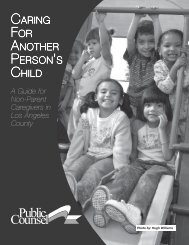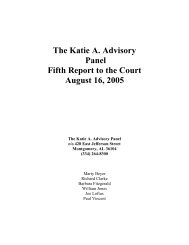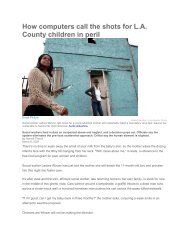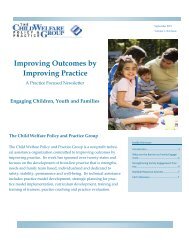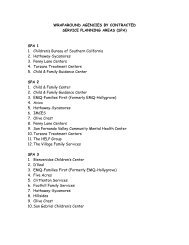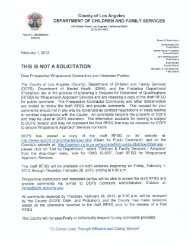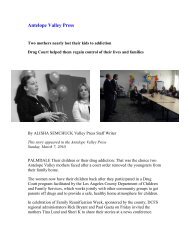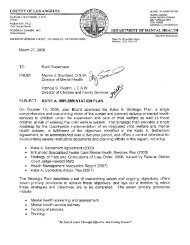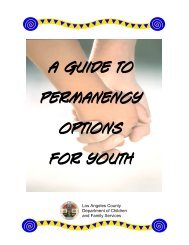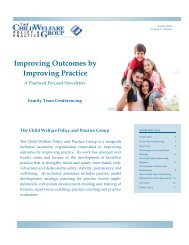Los Angeles County Self-Assessment Report
Los Angeles County Self-Assessment Report
Los Angeles County Self-Assessment Report
Create successful ePaper yourself
Turn your PDF publications into a flip-book with our unique Google optimized e-Paper software.
P3 services are being provided at each of the DCFS offices, with one or more staff<br />
assigned to each office. Currently, there are 74 P3 CSWs and 12 P3 SCSWs, working<br />
part-time, with most being DCFS retirees (not to exceed 120 days per year). While P3<br />
services are available for all regional offices, L.A. <strong>County</strong> plans to further expand<br />
resources for P3 due to its success in achieving permanency for youth.<br />
Each office has created a process to refer youth that are 12-18 years old and in long<br />
term foster care to their P3 staff. Once the P3 section receives the referral, it is<br />
screened for suitability and, if accepted, assigned to a P3 worker.<br />
As of September 2007, P3 has provided P3 services to 2099 youth. Approximately,<br />
39% (832) of the youth now have a legally permanent plan identified or established. A<br />
total of 57 youth have returned home to a parent and had their child welfare case<br />
closed, 25 youth have returned home and continue to have their case supervised by<br />
DCFS and 157 are moving towards reunification with a parent. In addition, 10 youth<br />
have been adopted, 5 youth are in adoptive placements and 242 youth who were<br />
previously opposed to adoption are now involved in adoption planning. Finally, 25 youth<br />
have had a legal guardian appointed and their cases closed through KinGAP, 84 youth<br />
are in a legal guardianship and continue to have their case supervised by DCFS and<br />
227 youth have a plan of legal guardianship identified and are moving through the court<br />
process.<br />
Concurrent Planning Redesign:<br />
Concurrent Planning Redesign has been developed as a joint Labor-Management<br />
initiative to address the goal of returning children that have entered foster care into safe,<br />
stable, and lifelong homes. In working towards this goal, the Concurrent Planning<br />
Redesign Pilot Phase I and Phase II have been implemented in order to serve all<br />
children in out-of-home care. The concept of concurrent planning involves setting up an<br />
alternative permanent plan, while at the same time providing Family Reunification<br />
Services for a detained child. Simultaneously preparing for an alternative permanent<br />
plan while working with a family toward Family Reunification does not mean that DCFS<br />
is not committed to assisting the family to strengthen itself; it means that DCFS is<br />
committed to providing timely permanence for children. Planning for permanence<br />
ensures that all reasonable efforts to safely maintain the child at home, or safely reunify<br />
the child with his or her family will be made. It also means that if the child cannot be<br />
maintained in or returned to the family of origin, another permanent family is prepared to<br />
meet the child’s need for permanence in a timely manner.<br />
<strong>Los</strong> <strong>Angeles</strong> <strong>County</strong> DCFS Concurrent Planning Redesign initiative began the spring of<br />
2004 at the first of many labor/management collaborative meetings. The collaborative<br />
meetings resulted in the implementation of systemic changes which are now known as<br />
24



